Excerpts from Jim Conrad's
Naturalist Newsletter
Entry from field notes dated August 31, 2023, taken in Los Mármoles National Park in the Eastern Sierra Madre mountains, Hidalgo state, MÉXICO, along steeply climbing road heading eastward out of town of Trancas {on maps designated "Morelos (Trancas)"} toward Nicolás Flores; juniper/pine forest on limestone bedrock; elevation ~2,200m (~7,200ft); (~N20.801°, ~W99.254°)
GIBASIS PULCHELLA
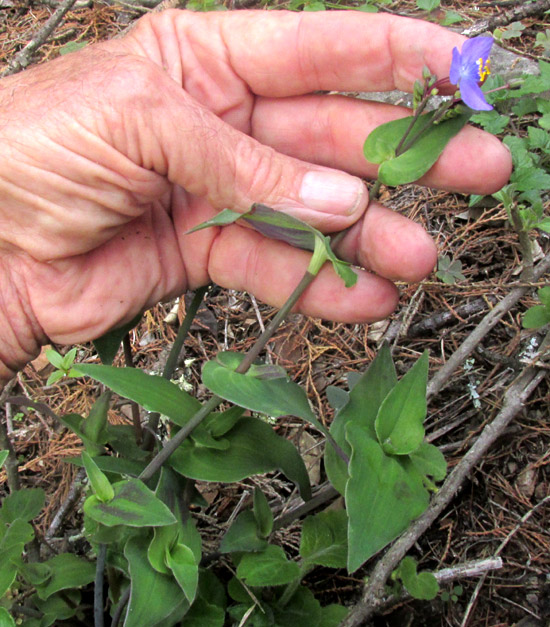
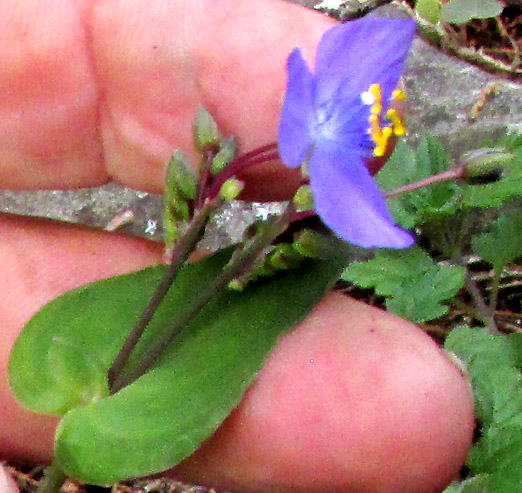
At first the above wildflower, with its blossoms' three showy petals and parallel-veined leaves, looked like just another somewhat weedy spiderwort of the genus Tradescantia, such as the Purple Spiderwort. However, at the right you see that, unlike in Tradescantia, this plant's cluster of flowers, or inflorescence, is not mostly hidden within a scoop-like bract folded into a spathe. Bracts are modified leaves, and spathes are bracts enclosing flower clusters. Our plant's flowers arise on plainly visible stalks, or pedicels. Still, the overall similarity to the spiderworts is so strong that it's clear that here we have something more interesting than just another spiderwort of the Spiderwort or Dayflower Family, the Commelinaceae.
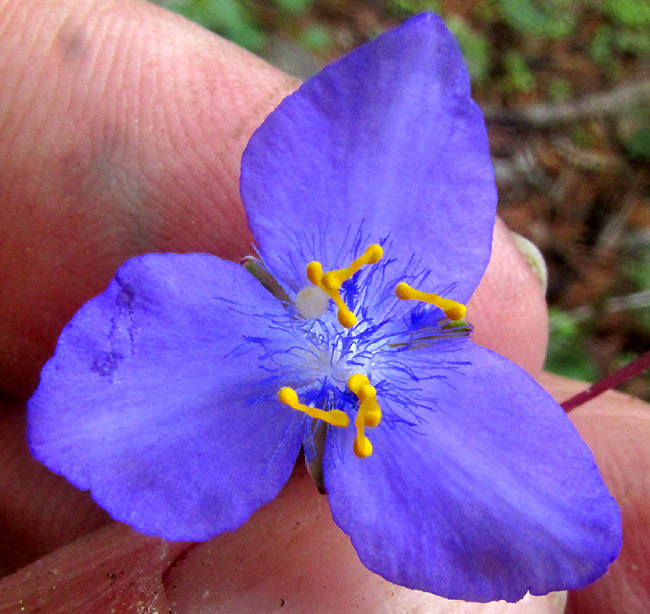
However, above, that certainly looks like a spiderwort flower: A radially symmetrical flower with three petals, six stamens, conspicuous yellow anthers atop "bearded" filaments surrounding a single style with a simple white stigma -- all just right for Tradescantia flowers. Here's what that surprisingly pretty arrangement looks like from the side:
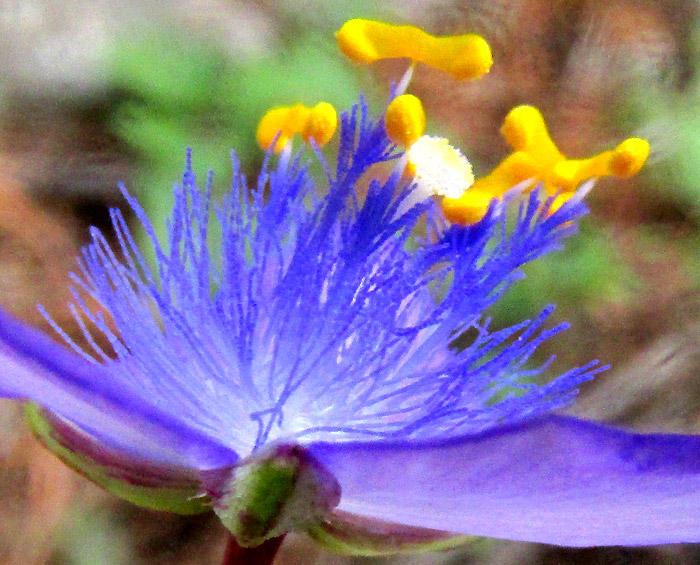
The corolla is subtended by three green, separate sepals, which also is typical of the genus Tradescantia:
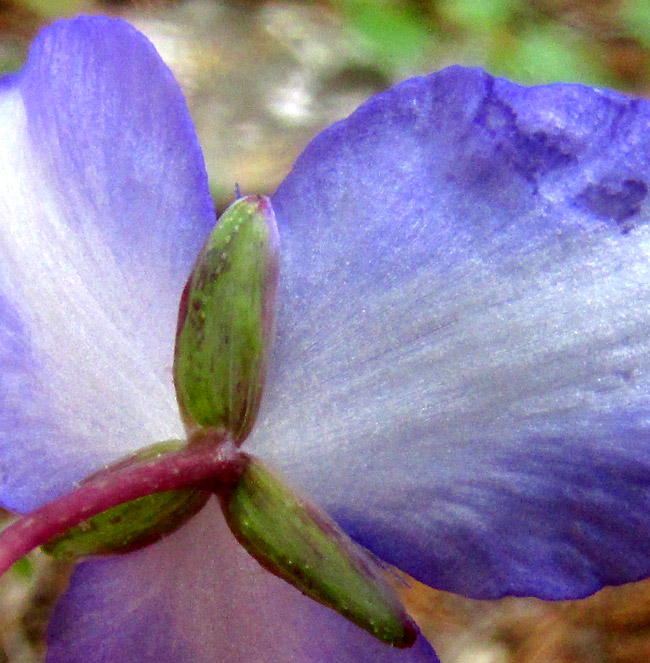
Even the curious manner by which our plant's leaf bases wrap around the stems often is among spiderwort species:

Below, you have view from below of the wrap-around, or "amplexicaul," leaf base; note the leaf undersurface's purplish tint, which is also a feature of some spiderwort species:
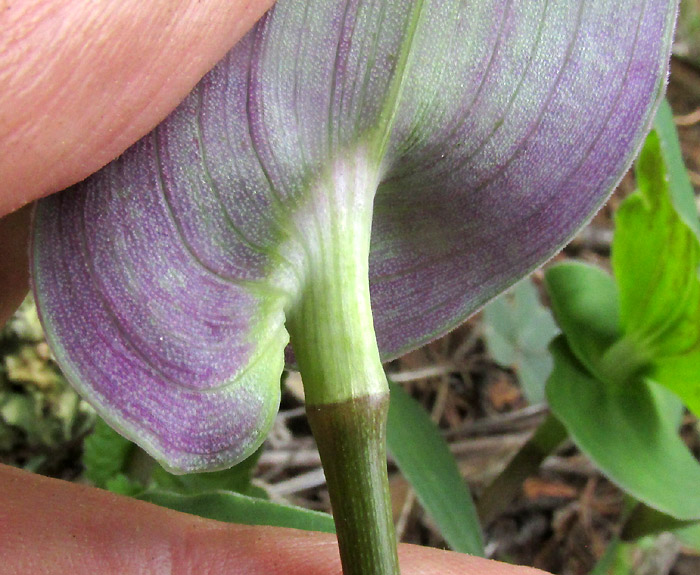
In the end, this is simply a spiderwort, except for the lack of a scoop-like bract folded into a spathe mostly hiding the inflorescence. However, in the Spiderwort Family, inflorescence-hiding spathes are a big deal, and that matter alone assigns our plant into a different genus. You can see scoop-like bracts folded into flower-sheltering spathes on our Gentian-leaved Spiderwort page.
In this part of the world, if your Spiderwort Family member bears radially symmetrical flowers with six stamens, all of which are of approximately the same length and on straight, not jointed and bent, filaments, you have the genus Gibasis. And on the phylogenetic Tree of Life, as you might guess, Gibasis appears very close to the spiderwort genus Tradescantia.
This close relationship is confirmed in the 2017 study by Marco O. O. Pellegrini entitled "Morphological phylogeny of Tradescantia L. (Commelinaceae) sheds light on a new infrageneric classification for the genus and novelties on the systematics of subtribe Tradescantiinae." That study concluded that "... Tradescantia is sister to the clade composed by Gibasis+Elasis." In phylogeny, sister taxa are those which have arisen from a common ancestor, thus are closely related like brothers and sisters. You might enjoy seeing a variation on the Gibasis theme, on our Gibasis venustula page. That species produced narrower leaves, and preferred the semiarid scrub of the altiplano's lower elevations.
The 2021 study by José Luis Villaseñor and others entitled "Riqueza y distribución de la flora vascular del estado de Hidalgo, México" lists five Gibasis species occurring in Mexico's Hidalgo state. Of those five species, if your plant's corollas are blue, the flowers are paired within the inflorescence and not grouped in bunches of 3-7, and the leaves are hairless on both surfaces, you have GIBASIS PULCHELLA.
Gibasis pulchella isn't well documented or photographed, but its distribution appears to include most of upland Mexico, and is concentrated in the central uplands. Some reports mention it in Guatemala and a disjunct occurrence in Colombia. The species bears no English name, though some taxa with larger, more diffuse inflorescences are known as bridal veils.
In North America, indigenous people ate the leaves and roots of various spiderwort species; leaves and flowers were edible raw. Poultices of mashed-up plants were applied to heal wounds and hemorrhoids, plus there were various other uses. I'd guess that in Mexico there's a similar history of use with this almost-spiderwort species, though the species is little recognized in the literature. It's just in lists and floras botanists make of species occurring at specific locations.